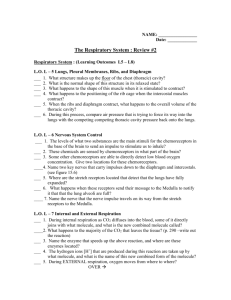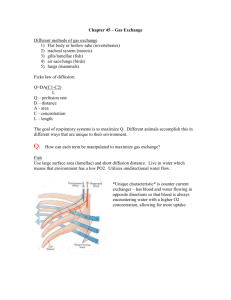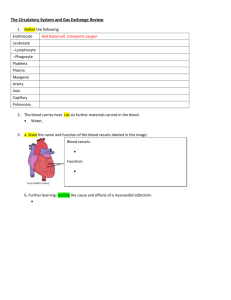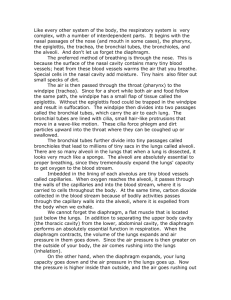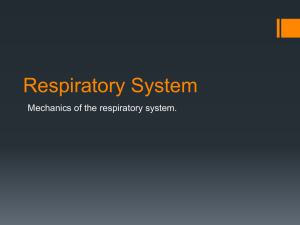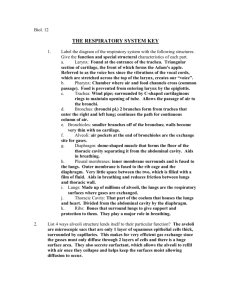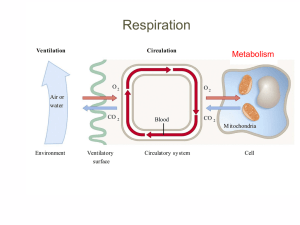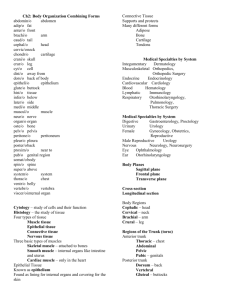BY 124 Mock Exam #3 True/False True or False: A swim bladder
advertisement
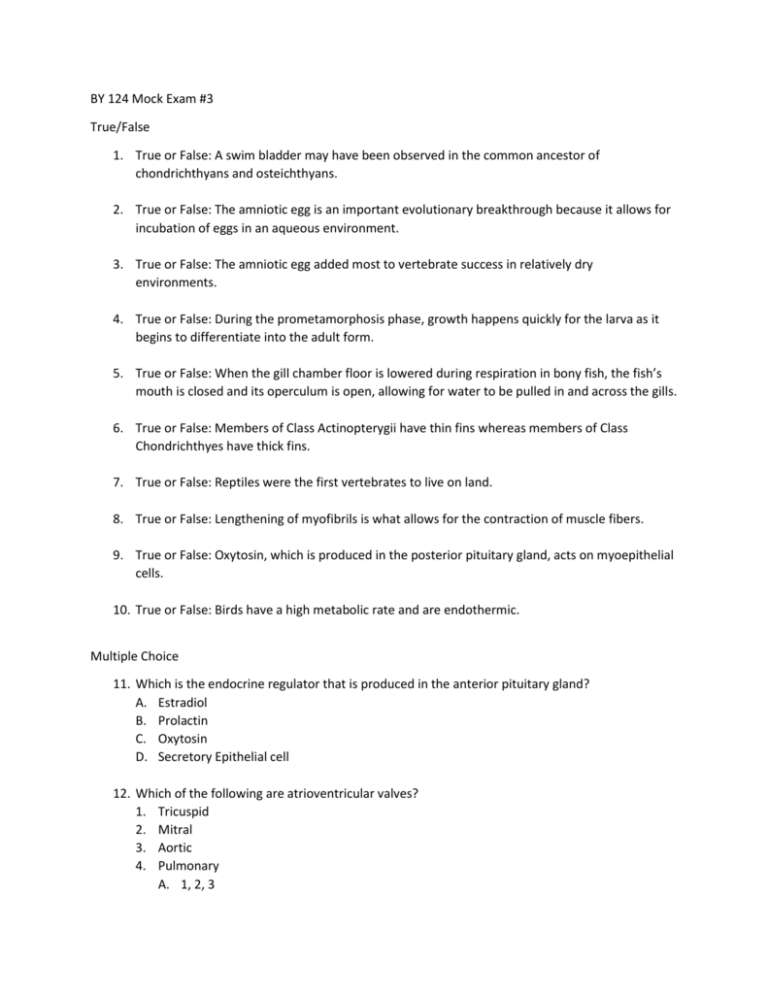
BY 124 Mock Exam #3 True/False 1. True or False: A swim bladder may have been observed in the common ancestor of chondrichthyans and osteichthyans. 2. True or False: The amniotic egg is an important evolutionary breakthrough because it allows for incubation of eggs in an aqueous environment. 3. True or False: The amniotic egg added most to vertebrate success in relatively dry environments. 4. True or False: During the prometamorphosis phase, growth happens quickly for the larva as it begins to differentiate into the adult form. 5. True or False: When the gill chamber floor is lowered during respiration in bony fish, the fish’s mouth is closed and its operculum is open, allowing for water to be pulled in and across the gills. 6. True or False: Members of Class Actinopterygii have thin fins whereas members of Class Chondrichthyes have thick fins. 7. True or False: Reptiles were the first vertebrates to live on land. 8. True or False: Lengthening of myofibrils is what allows for the contraction of muscle fibers. 9. True or False: Oxytosin, which is produced in the posterior pituitary gland, acts on myoepithelial cells. 10. True or False: Birds have a high metabolic rate and are endothermic. Multiple Choice 11. Which is the endocrine regulator that is produced in the anterior pituitary gland? A. Estradiol B. Prolactin C. Oxytosin D. Secretory Epithelial cell 12. Which of the following are atrioventricular valves? 1. Tricuspid 2. Mitral 3. Aortic 4. Pulmonary A. 1, 2, 3 B. 1, 3 C. 1, 2 D. 3, 4 13. Organisms in which a circulating body fluid is distinct from the fluid that directly surrounds the body’s cells are likely to have which of the following? A. Open circulatory system B. Gastrovascular cavity C. Lungs D. Hemolymph E. Closed circulatory system 14. A patient has a blood pressure of 120/75, a pulse rate of 40 beats/min, a stroke volume of 70mL/beat, and a respiratory rate of 25 breaths/min. This person’s cardiac output per minute will be A. 500 mL B. 1200 mL C. 3000 mL D. 2800 mL 15. Damage to the sinoatrial node in humans A. Would disrupt the rate and timing of cardiac muscle contractions B. Would have a negative effect on peripheral resistance C. Would block conductance between the bundle branches and the Purkinje fibers D. Would have a direct effect on blood pressure monitors in the aorta 16. What would be the long-term effect if the lymphatic vessels associated with a capillary bed were to become blocked? A. Blood pressure in the capillary bed would increase B. Fluid would accumulate in interstitial areas C. Fewer proteins would leak into the interstitial fluid from the blood D. Nothing would happen 17. A blood vessel has the following characteristics: outer layer of connective tissue, a thick layer of smooth muscle with elastic fibers, no valves. It is which of the following? A. Vein B. Venule C. Artery D. Capillary 18. What is the partial pressure of oxygen (PO2)? A. 160 mmHg B. 16 mm Hg C. 760 mm Hg D. 600 mm Hg 19. Air rushes into the lungs of humans during inhalation because A. Pressure in alveoli increases B. Gas flows from region of lower pressure to region of higher pressure C. Rib muscles and diaphragm contract, increasing lung volume D. Positive respiratory pressure created when the diaphragm relaxes 20. Which of the following occurs with the exhalation of air from human lungs? A. Diaphragm contracts B. Volume of thoracic cavity decreases C. Epiglottis closes D. Rib cage expands 21. Which of the following is true regarding the process of O2 binding to hemoglobin? A. Hb + O2 HbO2 B. When the partial pressure of oxygen is low, the reaction proceeds towards the products C. When the partial pressure of oxygen is low, the reaction proceeds towards the reactants D. Hemoglobin has 4 polypeptide chains 22. The blood level of which gas is most important in controlling human respiration rate? A. Nitric acid B. Nitrogen C. Oxygen D. Carbon dioxide 23. Breathing is usually regulated by A. Erythropoietin levels in the blood B. Concentration of red blood cells C. CO2 & O2 concentration and pH-level sensors D. Hemoglobin levels in the blood 24. Which of the following is not true of the mammalian heart? A. Composed mainly of cardiac muscle fibers B. Shortening of myofibrils is what allows muscle fibers to contract C. Connected by intercalated discs D. Electrical signals called action potentials causes relaxation of cardiac muscle fibers 25. Blood returning to the mammalian heart in a pulmonary vein drains first into the A. Left atrium B. Vena cava C. Right atrium D. Left ventricle 26. In negative pressure breathing, inhalation results from A. Forcing air from the throat down into the lungs B. Contracting the diaphragm C. Relaxing the muscles of the rib cage D. Contracting the abdominal muscles 27. Which of the following would lead in a shift of the oxygen dissociation curve to the right? A. An increase in affinity of O2 for Hemoglobin B. An increase in pH C. An increase in temperature D. A decrease in partial pressure of CO2 28. Which of the following is not true of CO2 transport in blood? A. About 7-10% of CO2 is transported as a dissolved gas B. Some CO2 is transported bound to Hemoglobin C. CO2 is produced as a byproduct of glucose oxidation D. The least amount of CO2 is transported as a bicarbonate ion 29. Which of the following is true of the transport of CO2 as HCO3-? A. CO2 combines with O2 to form carbonic acid B. This reaction is catalyzed by carbonic anhydrase C. Carbonic acid dissociates to bicarbonate and oxygen D. The bicarbonate ion, once formed, stays inside the red blood cell 30. How is most of the carbon dioxide transported by the blood in humans? A. Bicarbonate ions in plasma B. Bicarbonate ions in red blood cells C. CO2 attached to hemoglobin D. Carbonic acid in erythrocytes 31. True or False: The chloride shift involves the inward transport of bicarbonate ions and the outward transport of chloride ions. 32. True or False: When a mammal inhales, the rib cage expands as the rib muscles contract and the diaphragm also contracts. 33. True or False: When the partial pressure of CO2 is low, more bicarbonate ions tend to be formed. 34. True or False: The sinoatrial (SA) node is a cluster of autorhythmic cells located in the left atrium which sets the rate and timing at which all cardiac muscle cells contract. 35. True or False: Both arteries and veins have two layers of tissues surrounding the endothelium: an outer layer of connective tissue and a middle layer of smooth muscle. 36. Which of these speed up heart rate? A. Lipoproteins B. Immunoglobins C. Erythropoietin D. Epinephrine 37. Which of the following extraembryonic membranes is not paired correctly with its function? A. Chorion – outermost membrane, allows gases to diffuse across the shell B. Amnion – fluid-filled sac C. Yolk sac – nitrogen waste depository D. Yolk – energy source for developing embryo 38. Which of the following is a characteristic of Class Chondrichthyes? A. Absence of jaw B. Bony skeleton C. Spiral valve in intestine D. Thin fins 39. True or False: Carbon dioxide moves against its partial pressure gradient. 40. Which of the following statements is incorrect? A. During normal inspiration, the diaphragm contracts, inflating the lungs. B. During forced inspiration, the diaphragm contracts and the external intercostals contract, pushing the ribs down. C. During normal expiration, the diaphragm relaxes and the lungs deflate. D. During forced expiration, the diaphragm relaxes. 41. What is the name of the membrane that surrounds the thoracic cavity? A. Parietal pleura B. Visceral pleura C. Intrapleura D. Chorion 42. True or False; There is a drop in blood pressure from the arteriole to the ventricle end of the capillary. 43. Which of the following statements is correct? A. Sympathetic motor neurons release norepinephrine, which decreases heart rate. B. Sympathetic motor neurons release acetylcholine, which decreases heart rate. C. Adrenal medulla releases epinephrine, which increases heart rate. D. Parasympathetic motor neurons release acetylcholine, which increases heart rate. 44. True or False: All reptiles are ectothermic. 45. Order the following steps of blood flow in the pulmonary circuit: 1. Oxygen-rich blood flows into the left ventricle 2. Contraction of right ventricle pumps blood to the lungs via pulmonary arteries 3. Net diffusion of O2 from blood to tissues and of CO2 into blood 4. Oxygen poor-blood enters veins and venae cavae empty blood into right atrium 5. Oxygen rich blood returns from lungs via pulmonary veins to left atrium 6. Oxygen poor blood flows into right ventricle A. 1, 3, 4, 5, 2, 6 B. 3, 4, 5, 6, 2, 1 C. 6, 4, 3, 5, 2, 1 D. 2, 5, 1, 3, 4, 6 46. True or False: When precapillary sphincters are relaxed, more blood flows through the capillary from venules to arterioles. 47. Which of the following is incorrect regarding mammalian respiration? A. Mammalian lungs fill by negative pressure. B. There is an indirectly proportional relationship between volume and pressure. C. Lungs fill when pressure in the thoracic cavity is less than atmospheric pressure. D. Lungs fill when pressure in the atmosphere is less than pressure in the thoracic cavity. 48. Which of the following affects Hemoglobin’s affinity for O2? A. Temperature B. pH C. CO2 D. All of the above 49. True or False: Oxygen-poor blood is delivered to the alveoli and pulmonary veins transport oxygen-rich blood from the alveoli back to the heart. 50. Which of the following is true of negative pressure breathing in mammals? A. Muscle contraction expands the thoracic cavity, which raises air pressure inside lungs above that of air outside their body B. Gas flows from regions of lower pressure to regions of higher pressure C. During exhalation, muscles controlling thoracic cavity relax & volume in cavity is reduced D. Decreased air pressure in alveoli forces air up the breathing tubes and out of the body

